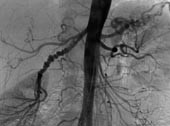Peer Reviewed
Feature Article Renal medicine
Renal artery stenosis and hypertension: whom and how to screen and treat
Abstract
Renovascular disease is an underlying cause in a significant proportion of patients who have refractory hypertension. Aggressive medical therapy to lower cardiovascular risk is the first priority in these patients. Endovascular treatment is required in only a few carefully selected cases.
Key Points
- Renovascular disease is common and is an underlying cause in a significant proportion of patients who have refractory hypertension.
- The appropriate selection of patients for investigation and subsequent interventional treatment is the key. Interventional treatment for severe renal artery stenosis (RAS) is reasonable in patients with poorly controlled hypertension despite taking more than four antihypertensive agents, pulmonary oedema with normal left ventricular systolic function, a progressive decline in renal function or recent end-stage kidney disease.
- Although magnetic resonance angiography and spiral computed tomography angiography are more accurate than other imaging techniques in detecting RAS, the benefits of these modalities must be weighed against their potential side effects.
- Appropriate medical therapy with multiple medications, including antihypertensive agents, antiplatelet agents and statins, is probably as effective in the nonselected population as interventional therapies.
- Cardiovascular mortality is high in patients with RAS: the key aim of therapy is to target cardiovascular risk factors to prevent mortality and morbidity.

